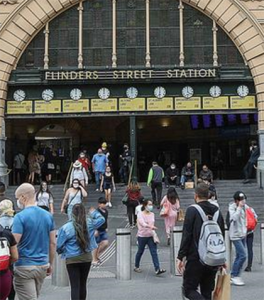Melbourne population growth takes a COVID hit
Melbourne’s population will flat line this year because the COVID pandemic has halted overseas immigration, according to a new report.
The study says the city will have 540,000 fewer people in 20 years than was recently forecast.
 High immigration has been slashed due to the pandemic shutting down international travel over the past year.
High immigration has been slashed due to the pandemic shutting down international travel over the past year.
Net overseas migration to Australia was about 240,000 in 2018-19, but this year is projected to be negative 71,600.
Demographic consultancy .id says this means Greater Melbourne will grow by only 12,000 people in 2020-21, compared to an extra 114,000 just two years earlier.
The firm says Melbourne will grow from 5.2 million people today to just 6.7 million in 2041; when pre-pandemic estimates had the population at more than 7.2 million by then.
Demographer Johnny Barnard said the trend would continue until a comprehensively rolled out vaccine allowed international borders to open by the end of 2022.
“It will be a slow return getting overseas migration back, and particularly Melbourne is affected by that drop in migration,” he said.
Hardest hit is the ABS statistical area of Inner Melbourne, whose population is tipped to fall by 6000 to 713,686 by mid-2021.
Other areas with falling population numbers are Melbourne Inner East (down 2545 to 401,541), Melbourne Outer East (down 1037 to 536,573) and Melbourne South East (down 643 to 452,130).
Victorian Treasurer Tim Pallas said he was concerned about the effect of the pandemic on central city businesses and apartment market.
“We need to recognise there’s not just one formula for construction, that is own-your-own house or apartment,” he told an Urban Development Institute of Australia event.
”We have to start thinking a bit more creatively about alternatives…whether it’s build-to-rent or any other variance on that theme,” Mr Pallas said.
“We’ve been given a bit of time – it should be seen as a respite in terms of population growth – but I don’t think anybody would be so foolhardy to assume that population won’t come back, and come back strongly into the future.”
The analysis showed that regional Victoria’s population was estimated at 1.87 million by 2041, about 93,000 lower than the previous forecast.
During 2020-21, Ballarat’s population is due to grow by 2000 to 172,212, Bendigo’s by 2100 to 166,846 and Greater Geelong’s by 5500 to 322,688.












